Theme Parks & Themed Entertainment
The Folks Who do it Right: The Tokyo Disney Resort at Halloween

At heart I'm just a kid, and one of the things I most look
forward to every year is trick or treating with my young daughter. The first
year we took her out, age 2, I realized how much I had missed it. Seems silly,
doesn't it? One of the nice things about having a child is that you get to
reclaim parts of your own childhood-if for just a few years. It's a short-lived
gift, but a rich one.

The Walt Disney Company has been slowly figuring out the
same thing: adults like Halloween just as much as kids, and parents enjoy
Halloween with their kids. But I don't really want the bejesus scared out of
me, so Universal's Halloween Horror Nights are too horrible. They conflict with
the Halloween that became part of my psyche many decades ago. There's an
innocence to "my" Halloween, one that meshes perfectly with my love of Disney
theme parks. Put the two together and you get my little patch of heaven: going
to Disney during autumn when their Halloween decorations have transformed the
parks into celebrations of orange and black … pumpkins and ghosts, friendly
witches and non-threatening vampires.

In the United States, Disneyland in Anaheim inaugurated
"Mickey's Halloween Treat" in 1995, but abandoned it after 1996 until the event
reappeared at California Adventure in 2005. Walt Disney World has been holding
"Mickey's Not-So-Scary Halloween Party" for over a decade. Both are hard-ticket
events, meaning that currently you have to pay between $54 and $59 per adult at
Disneyland, and $70 at Walt Disney World. The past two years have also seen the
event at Disneyland Paris for between $36 and $45. (The event in Paris has its
own distinct flavor, with fewer Disney characters and little more "edge.")
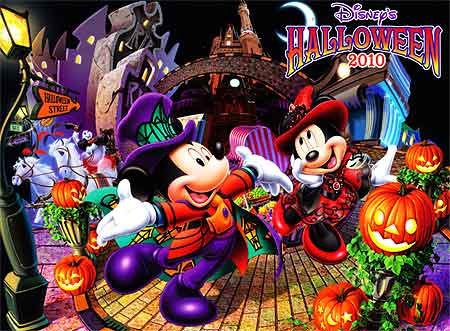
Copyright Disney Enterprises, Inc. All
rights reserved
At the Tokyo Disney Resort you pay … nothing. The event runs
day and night from September 9 to October 31 and includes special parades,
shows, fireworks, meals, souvenirs, and a park so thoroughly and impressively
decorated it's almost impossible for an American to imagine, and you get it all
included in your regular theme park admission (which in Tokyo is less than at
any American Disney park).

Photo by Jack Thornton
Tokyo Disneyland's Halloween celebration started slowly because the
holiday, prior to Disney's introduction of it, was little known in Japan. It's
not a Christian culture and has no history of the All Hallows Eve in Ireland
and Scotland that transmogrified into Halloween in the U.S.A. as immigrants
from those countries assimilated into our culture in the early 1900s.
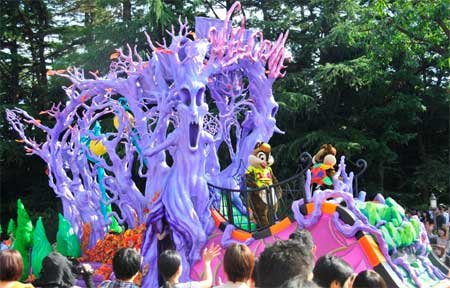
Photo by Jack Thornton
In 1999 the Oriental Land Company, owner of Tokyo
Disneyland, tried a modest event limited to the Toontown and Haunted Mansion
area aimed at children and their parents, who were invited to dress in costume.
The event took place only on October 31 and consisted of two parade-style
antique cars each containing four Halloween-costumed Disney characters (I guess
you'd call them the "Fab Eight"), 400 costumed guests, and a few cast members
in scarecrow costumes dancing in front of a single float of a Mickey pumpkin head
at the end. Titled the "Happy Halloween Twilight Parade," you can watch it here on
YouTube.

Photo by Jack Thornton
While Halloween has grown in popularity in Japan in the
ensuing decade, for most participants it consists of dressing in costume and
going to parties in other's homes, or celebrations in school for children-trick
or treating from door to door does not exist. That's important to note because
it changes the dynamics of the event between the American and Japanese parks.

Photo by Jack Thornton
The Tokyo Disney Resort, like Disneyland in California, is
essentially a local park-most of the visitors live within a few hours' distance
by car or rail. The Oriental Land Company has mastered the art of seasonal
events that draw their customer base to the parks in an almost frenzied way.
Every season has a major event with new park décor, parades, shows,
merchandise, and so much more that it exceeds anything, even for Christmas,
done at either Disneyland or Walt Disney World, because in Japan almost
everything changes each year.
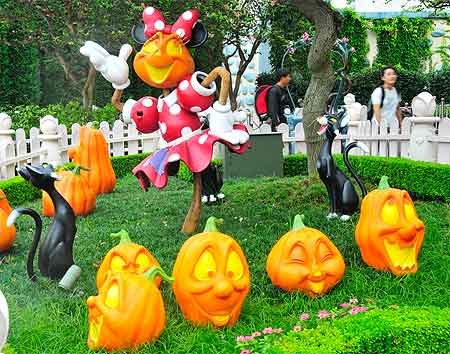
Photo by Jack Thornton
Cute is what the Japanese crave, the opposite of the
Chinese, whose Halloween celebration at Hong Kong Disneyland has zombies,
ghouls, and aliens more akin to the horrors at a Universal theme park. And on
"cute" Tokyo Disneyland delivers in an enormous way. Virtually every building
in every land (Tomorrowland oddly excepted) is decorated in orange and black
bunting, banners, signs, all with Halloween characters. The park is filled with
statues of happy ghosts cavorting and thousands of pumpkin characters. And
almost every year the theme, costumes, parade, and artwork change completely.

Photo by Jack Thornton
The enormous hub is filled with various scenes of Disney
characters enjoying Halloween dressed to match that year's theme. In 2010 there
were three tableaux: the main one with Mickey and Minnie and a hearse pulled by
ghostly horses (along with a few ghostly sewer workers peeking out from beneath
the ground); the secondary one with a graveyard featuring images of the Fab
Five, but these were no ordinary tombstones and statues. Like the busts in the
Haunted Mansion, all follow as you walk past-an amazing illusion; the third
tableau is also based on an optical illusion, that of a Mickey-eared Jack o'
Lantern that only appears whole when viewed through a lens directly in front of
it. From the side it's a hodge-podge of seemingly unrelated columns. Life-size
ghosts sit on various benches, waiting for you to pose beside them for a photo.
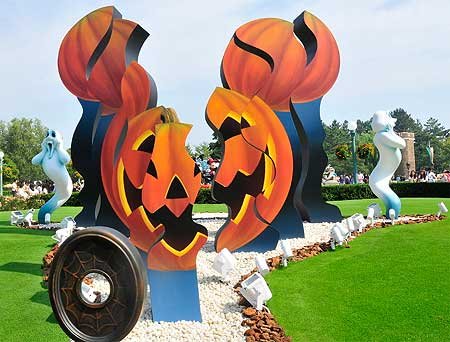
The pieces ultimately come
together … Photo by Jack Thornton

… once you look through the lense. Photo by Jack
Thornton
The souvenirs are endless, and are highly collectible
because they change every year. Among the most unique are the Halloween Disney
character cellphone dangles which can be personalized with your name. There are
also special small ceramic plates and cups decorated with the year's
Halloween-themed artwork featuring roll cake and mousse. Numerous
Halloween-themed meals are offered around the resort, the most creative being
DisneySea's rice dinner in the shape of a skull. Halloween flavors abound:
there are pumpkin churros, pumpkin soft-serve ice cream, Mickey pastries filled
with pumpkin custard, and pumpkin soup.
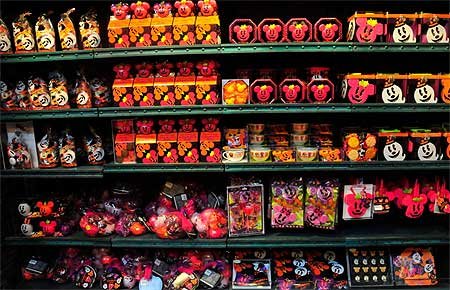
Photo by Jack Thornton
In 2004, The Nightmare Before Christmas
overlay from
Anaheim's Disneyland, having proven hugely popular, was brought to Tokyo
Disneyland as "Haunted Mansion Holiday Nightmare" to create an actual Halloween
themed attraction for the seasonal event. With Tokyo's Haunted Mansion a
plussed-duplicate of Orlando's rather than Anaheim's, there are quite a few
differences and improvements in the Tokyo version, including additional
Audio-Animatronic figures. Its popularity means routine wait times of 70 to 120
minutes. And there are dozens of new souvenirs every fall to accompany its
reopening-and they're not just the generic Nightmare Before Christmas themed
merchandise you find at Disneyland, but fully themed to the attraction itself.
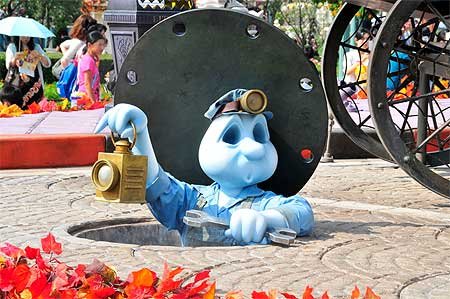
Photo by Jack Thornton
The Oriental Land Company, finding Tokyo Disneyland
overwhelmed with Halloween celebrants while next door DisneySea sat relatively
empty, last year decided to expand the seasonal event. The Halloween stage show
moved from in front of Cinderella's Castle over to the park abutting
DisneySea's Tower of Terror and turned into Mysterious Masquerade, a show so
popular that there is often a wait-time of 60 minutes just to attempt to get a
ticket by lottery. The first season of Halloween at DisneySea was confined to
only the front of Mediterranean Harbor, the American Waterfront, and Cape Cod
areas. This year the decorations have spread into Lost River Delta, a
South-American themed area, with Day of the Dead decor and a mini-parade
featuring Chip and Dale. It fits perfectly and I think we can expect Halloween
to expand to the other "ports" in DisneySea in future years.
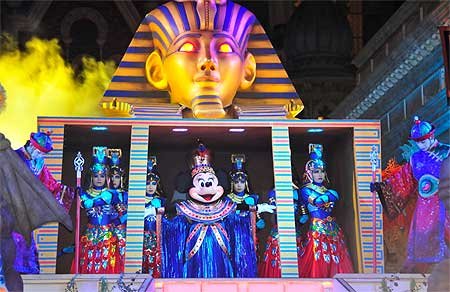
Photo by Jack Thornton
The result of the Oriental Land Company's free seasonal
events now at both Tokyo Disneyland and DisneySea keeps the parks packed almost
year round. Because trick or treating isn't part of Japan's Halloween culture,
the lure of having candy stations all over the park for tricks or treats isn't
something the Japanese necessarily understand or want-and I think that giving
away enormous amounts of candy to kids is a big part of what justifies paying
such a high price for a ticket to the Halloween events at Walt Disney World and
Disneyland. Imagine what would happen if those shopping bags full of free
candy, all that "trick or treating," were removed from the events at the
American parks … the Walt Disney Company would have a much harder time selling
tickets. Halfway around the world, the only evidence of trick or treating at
the Tokyo Disney Resort are one or two caped cast members in DisneySea, holding
pumpkin buckets and handing out a single small piece of hard candy in a
Halloween-event-dated souvenir wrapping.
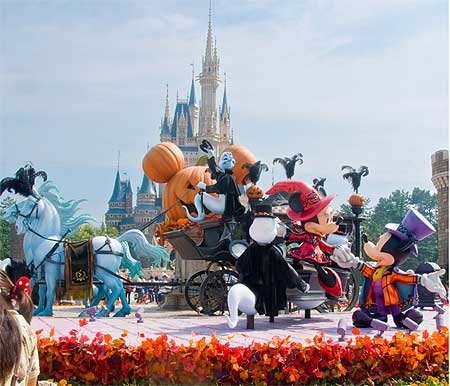
Photo by Jack Thornton
Do I miss the enormous haul of candy to be had at the
American parks for half a C-note? Not in the slightest. I'll take the new
themes, decorations, parades, music, shows, special dinners, desserts, and
souvenirs at the Tokyo Disney Resort-included with my normal-priced
passport-any day.

Copyright Disney Enterprises, Inc.
All rights reserved
Personally, I think that there's one more attraction just
begging for a Halloween overlay at Tokyo Disneyland-does anyone out there not
want to see the Country Bears singing "The Monster Mash"?

Photo by Jack Thornton
Your thoughts?
Theme Parks & Themed Entertainment
Disney and Macy’s 90-Year Thanksgiving Day Parade Partnership: From Mickey’s First Balloon to Minnie’s Big Debut

Now, folks, if you’re like me, Thanksgiving just wouldn’t be the same without a coffee, a cozy seat, and Macy’s Thanksgiving Day Parade on the TV. And if you’re really like me, you’re watching for one thing: Disney balloons floating down 34th Street. Ever wondered how Mickey, Donald, and soon Minnie Mouse found their way into this beloved New York tradition? Well, grab your popcorn because we’re diving into nearly 90 years of Disney’s partnership with Macy’s.
The Very First Parade and the Early Days of Balloons
The Macy’s Thanksgiving Day Parade goes way back to 1924, but if you can believe it, balloons weren’t part of the festivities until 1927. That first lineup included Felix the Cat, a dragon, and a toy soldier, all towering above the crowds. Back then, Macy’s had a pretty wild idea to end the parade: they would let the balloons drift off into the sky, free as birds. But this wasn’t just Macy’s feeling generous. Each balloon had a message attached, offering a $100 reward (about $1,800 in today’s dollars) for anyone who returned it to the flagship store on 34th Street.
And here’s where it gets interesting. This tradition carried on for a few years, right up until 1932, when Felix the Cat almost took down a plane flying over New York City! Imagine that—you’re flying into LaGuardia, and suddenly, there’s a 60-foot balloon drifting toward your wing. Needless to say, that was the end of Macy’s “fly away” stunt, and from then on, the balloons have stayed firmly grounded after the parade ends.

1934: Mickey Mouse Floats In, and Disney Joins the Parade
It was 1934 when Mickey Mouse finally made his grand debut in the Macy’s parade. Rumor has it Walt Disney himself collaborated with Macy’s on the design, and by today’s standards, that first Mickey balloon was a bit of a rough cut. This early Mickey had a hotdog-shaped body, and those oversized ears gave him a slightly lopsided look. But no one seemed to mind. Mickey was there, larger than life, floating down the streets of New York, and the crowd loved him.
Mickey wasn’t alone that year. He was joined by Pluto, Horace Horsecollar, and even the Big Bad Wolf and Practical Pig from The Three Little Pigs, making it a full Disney lineup for the first time. Back then, Disney wasn’t yet the entertainment powerhouse we know today, so for Walt, getting these characters in the parade meant making a deal. Macy’s required its star logo to be featured on each Disney balloon—a small concession that set the stage for Disney’s long-standing presence in the parade.
Duck Joins and Towers Over Mickey
A year later, in 1935, Macy’s introduced Donald Duck to the lineup, and here’s where things got interesting. Mickey may have been the first Disney character to float through the parade, but Donald made a huge splash—literally. His balloon was an enormous 60 feet tall and 65 feet long, towering over Mickey’s 40-foot frame. Donald quickly became a fan favorite, appearing in the lineup for several years before being retired.
Fast-forward a few decades, and Donald was back for a special appearance in 1984 to celebrate his 50th birthday. Macy’s dug the balloon out of storage, re-inflated it, and sent Donald down 34th Street once again, bringing a bit of nostalgia to the holiday crowd.
A Somber Parade in 2001
Now, one of my most memorable trips to the parade was in 2001, just weeks after the 9/11 attacks. Nancy and I, along with our friends, headed down to New York, and the mood was something I’ll never forget. We watched the start of the parade from Central Park West, but before that, we went to the Museum of Natural History the night before to see the balloons being inflated. They were covered in massive cargo nets, with sandbags holding them down. It’s surreal to see these enormous balloons anchored down before they’re set free.
That year, security was intense, with police lining the streets, and then-Mayor Rudy Giuliani rode on the Big Apple float to roaring applause. People cheered his name, waving and shouting as he passed. It felt like the entire city had turned out to show their resilience. Even amidst all the heightened security and tension, seeing those balloons—brought a bit of joy back to the city.

Balloon Prep: From New Jersey’s MetLife Stadium to California’s D23 Expo
Each year before the parade, Macy’s holds a rehearsal event known as Balloon Fest at MetLife Stadium in New Jersey. This is where handlers get their first crack at guiding the balloons, practicing with their parade masters, and learning the ropes—literally. It’s an entire production unto itself, with dozens of people rehearsing to make sure these enormous inflatables glide smoothly down the streets of New York on parade day.
In 2015, Macy’s took the balloon show on the road, bringing their Buzz Lightyear balloon out to California for the D23 Expo. I was lucky enough to be there, and watching Buzz get inflated piece by piece in the Anaheim Convention Center parking lot was something to behold. Each section was filled with helium in stages, and when they got around to Buzz’s lower half, well, there were more than a few gas-related jokes from the crowd.
These balloons seem to have a personality all their own, and seeing one like Buzz come to life up close—even outside of New York—had all the excitement and anticipation of the real deal.

Mickey’s Comeback as a Bandleader and Sailor Mickey
After a long hiatus, Mickey Mouse made his return to the Macy’s parade in 2000, this time sporting a new bandleader outfit. Nine years later, in 2009, Sailor Mickey joined the lineup, promoting Disney Cruise Line with a nautical twist. Over the past two decades, Disney has continued to enchant parade-goers with characters like Buzz Lightyear in 2008 and Olaf from Frozen in 2017. These balloons keep Disney’s iconic characters front and center, drawing in both longtime fans and new viewers.
But ever wonder what happens to the balloons after they reach the end of 34th Street? They don’t just disappear. Each balloon is carefully deflated, rolled up like a massive piece of laundry, and packed into storage bins. From there, they’re carted back through the Lincoln Tunnel to Macy’s Parade Studio in New Jersey, where they await their next flight.

Macy’s Disney Celebration at Hollywood Studios
In 1992, Macy’s took the spirit of the parade down to Disney-MGM Studios in Orlando. After that year’s parade, several balloons—including Santa Goofy, Kermit the Frog, and Betty Boop—were transported to Hollywood Studios, re-inflated, and anchored along New York Street as part of a holiday display. Visitors could walk through this “Macy’s New York Christmas” setup and see the balloons up close, right in the middle of the park. While this display only ran for one season, it paved the way for the Osborne Family Spectacle of Dancing Lights, which became a holiday staple at the park for years to come.

Minnie Mouse’s Long-Awaited Debut in 2024
This year, Minnie Mouse will finally join the parade, making her long-overdue debut. Macy’s is rolling out the red carpet for Minnie’s arrival with special pop-up shops across the country, where fans can find exclusive Minnie ears, blown-glass ornaments, T-shirts, and more to celebrate her first appearance in the Thanksgiving Day Parade.

For those lucky enough to catch the parade this year, you’ll see Minnie take her first float down 34th Street, decked out in her iconic red bow and polka-dot dress. Macy’s and Disney are also unveiling a new Disney Cruise Line float honoring all eight ships, including the latest, the Disney Treasure.
As always, I’ll be watching from my favorite chair, coffee in hand, as Minnie makes her grand entrance. The 98th annual Macy’s Thanksgiving Day Parade airs live on NBC, and it’s a tradition you won’t want to miss—whether you’re on 34th Street or tuning in from home.
Theme Parks & Themed Entertainment
Disney’s Forgotten Halloween Event: The Original Little Monsters on Main Street

When most Disney fans think of Halloween in the parks, they immediately picture Mickey’s Not-So-Scary Halloween Party at Walt Disney World or the Oogie Boogie Bash at Disneyland Resort. But before those events took over as the must-attend spooky celebrations, there was a little-known event at Disneyland called Little Monsters on Main Street. And its origins? Well, they go all the way back to the 1980s, during a time when America was gripped by fear—the Satanic Panic.

You see, back in the mid-1980s, parents were terrified that Halloween had become dangerous. Urban legends about drug-laced candy or razor blades hidden in apples were widespread, and many parents felt they couldn’t let their kids out of sight for even a moment. Halloween, which was once a carefree evening of trick-or-treating in the neighborhood, had suddenly become a night filled with anxiety.
This is where Disneyland’s Little Monsters on Main Street came in.

The Origins of Little Monsters on Main Street
Back in 1989, the Disneyland Community Action Team—later known as the VoluntEARS—decided to create a safe, nostalgic Halloween experience for Cast Members and their families. Many schools in the Anaheim area were struggling to provide basic school supplies to students, and the VoluntEARS saw an opportunity to combine a safe Halloween with a charitable cause. Thus, Little Monsters on Main Street was born.
This event was not open to the general public. Only Disneyland Cast Members could purchase tickets, which were initially priced at just $5 each. Cast Members could bring their kids—but only as many as were listed as dependents with HR. And even then, the park put a cap on attendance: the first event was limited to just 1,000 children.

A Unique Halloween Experience
Little Monsters on Main Street wasn’t just another Halloween party. It was designed to give kids a safe, fun environment to enjoy trick-or-treating, much like the good old days. On Halloween night in 1989, kids in costume wandered through Disneyland with their pillowcases, visiting 20 different trick-or-treat stations. They also had the chance to ride a few of their favorite Fantasyland attractions, all after the park had closed to the general public.
The event was run entirely by the VoluntEARS—about 200 of them—who built and set up all the trick-or-treat stations themselves. They arrived at Disneyland before the park closed and, as soon as the last guest exited, they began setting up stations across Main Street, Adventureland, Frontierland, Fantasyland, and Tomorrowland. The event ran from 7:30 to 9:30 p.m., and by the time the last pillowcase-wielding kid left, the VoluntEARS cleaned everything up, making sure the park was ready for the next day’s operations.
It wasn’t just candy and rides, though. The event featured unique entertainment, like a Masquerade Parade down Main Street, U.S.A., where kids could show off their costumes. And get this—Disneyland even rigged up a Cast Member dressed as a witch to fly from the top of the Matterhorn to Frontierland on the same wire that Tinker Bell uses during the fireworks. Talk about a magical Halloween experience!
The Haunted Mansion “Tip-Toe” Tour
Perhaps one of the most memorable parts of Little Monsters on Main Street was the special “tip-toe tour” of the Haunted Mansion. Now, Disneyland’s Haunted Mansion can be a pretty scary attraction for younger kids, so during this event, Disney left the doors to the Stretching Room and Portrait Gallery wide open. This allowed kids to walk through and peek at the Haunted Mansion’s spooky interiors without actually having to board the Doom Buggies. For those brave enough to ride, they could, of course, take the full trip through the Haunted Mansion—or they could take the “chicken exit” and leave, no harm done.

Growing Success and a Bigger Event
Thanks to the event’s early success, Little Monsters on Main Street grew in size. By 1991, the attendance cap had been raised to 2,000 kids, and Disneyland added more activities like magic shows and hayrides. They also extended the event’s hours, allowing kids to enjoy the festivities until 10:30 p.m.
In 2002, the event moved over to Disney California Adventure, where it could accommodate even more kids—up to 5,000 in its later years. The name was also shortened to just Little Monsters, since it was no longer held on Main Street. This safe, family-friendly Halloween event continued for several more years, with the last mention of Little Monsters appearing in the Disneyland employee newsletter in 2008. Though some Cast Members recall the event continuing until 2012, it eventually made way for Disney’s more public-facing Halloween events.

From Little Monsters to Mickey’s Not-So-Scary and Oogie Boogie Bash
Starting in the early 2000s, Disney began realizing the potential of Halloween-themed after-hours events for the general public. These early versions of Mickey’s Halloween Party and Mickey’s Halloween Treat eventually evolved into today’s Mickey’s Not-So-Scary Halloween Party and Oogie Boogie Bash. Unfortunately, this also marked the end of the intimate, Cast Member-exclusive Little Monsters event, but it paved the way for the large-scale Halloween celebrations we know and love today.
While it’s bittersweet to see Little Monsters on Main Street fade into Disney history, its legacy lives on through these modern Halloween parties. And even though Cast Members now receive discounted tickets to Mickey’s Not-So-Scary and Oogie Boogie Bash, the special charm of an event created specifically for Disney’s employees and their families remains something worth remembering.
The Merch: A Piece of Little Monsters History
For Disney collectors, the exclusive merchandise created for Little Monsters on Main Street is still out there. You can find pins, name tags, and themed pillowcases on sites like eBay. One of the coolest collectibles is a 1997 cloisonné pin set featuring Huey, Dewey, and Louie dressed as characters from Hercules. Other sets paid tribute to the Main Street Electrical Parade and Pocahontas, while the pillowcases were uniquely designed for each year of the event.

While Little Monsters on Main Street may be gone, it’s a fascinating piece of Disneyland history that played a huge role in shaping the Halloween celebrations we enjoy at Disney parks today.
Want to hear more behind-the-scenes stories like this? Be sure to check out I Want That Too, where Lauren and I dive deep into the history behind Disney’s most beloved attractions, events, and of course, merchandise!
Theme Parks & Themed Entertainment
The Story of Mickey’s Not-So-Scary Halloween Party: From One Night to a Halloween Family Tradition

The spooky season is already in full swing at Disney parks on both coasts. On August 9th, the first of 38 Mickey’s Not-So-Scary Halloween Party (MNSSHP) nights for 2024 kicked off at Florida’s Magic Kingdom. Meanwhile, over at Disney California Adventure, the Oogie Boogie Bash began on August 23rd and is completely sold out across its 27 dates this year.
Looking back, it’s incredible to think about how these Halloween-themed events have grown. But for Disney, the idea of charging guests for Halloween fun wasn’t always a given. In fact, when the very first Mickey’s Not-So-Scary Halloween Party debuted on October 31, 1995, it was a modest one-night-only affair. Compare that to the near month-long festivities we see today, and it’s clear that Disney’s approach to Halloween has evolved considerably.
A Not-So-Scary Beginning
I was fortunate enough to attend that very first MNSSHP back in 1995, along with my then 18-month-old daughter Alice and her mom, Michelle. Tickets were a mere $16.95 (I know, can you imagine?), and we pushed Alice around in her sturdy Emmaljunga stroller—Swedish-built and about the size of a small car. Cast Members, charmed by her cuteness, absolutely loaded us up with candy. By the end of the night, we had about 30 pounds of fun-sized candy bars, making that push up to the monorail a bit more challenging.

This Halloween event was Disney’s response to the growing popularity of Universal Studios Florida’s own Halloween hard ticket event, which started in 1991 as “Fright Nights” before being rebranded as “Halloween Horror Nights” the following year. Universal’s gamble on a horror-themed experience helped salvage what had been a shaky opening for their park, and by 1993, Halloween Horror Nights was a seven-night event, with ticket prices climbing as high as $35. Universal had stumbled upon a goldmine, and Disney took notice.
A Different Approach
Now, here’s where Disney’s unique strategy comes into play. While Universal embraced the gory, scare-filled world of horror, Disney knew that wasn’t their brand. Instead of competing directly with blood and jump-scares, Disney leaned into what they did best: creating magical, family-friendly experiences.
Thus, Mickey’s Not-So-Scary Halloween Party was born. The focus was on fun and whimsy, not fear. Families could bring their small children without worrying about them being terrified by a chainsaw-wielding maniac around the next corner. This event wasn’t just a Halloween party—it was an extension of the Disney magic that guests had come to expect from the parks.
Disney had some experience with seasonal after-hours events, most notably Mickey’s Very Merry Christmas Party, which had started in 1983. But the Halloween party was different, as the Magic Kingdom wasn’t yet decked out in Halloween decor the way it is today. Disney had to create a spooky (but not too spooky) atmosphere using temporary props, fog machines, and, of course, lots of candy.
A key addition to that first event? The debut of the Headless Horseman, who made his eerie appearance in Liberty Square, riding a massive black Percheron. It wasn’t as elaborate as the Boo-to-You Parade we see today, but it marked the beginning of a beloved Disney Halloween tradition.
A Modest Start but a Big Future
That first MNSSHP in 1995 was seen as a trial run. As Disney World spokesman Greg Albrecht told the Orlando Sentinel, “If it’s successful, we’ll do it again.” And while attendance was sparse that night, there was clearly potential. By 1997, the event expanded to two nights, and by 1999, Mickey’s Not-So-Scary Halloween Party had grown into a multi-night celebration with a full-fledged parade. Today, in 2024, it’s a staple of the fall season at Walt Disney World, offering 38 nights of trick-or-treating, character meet-and-greets, and special entertainment.
Universal’s Influence

It’s interesting to reflect on how Disney’s Halloween event might never have existed without the competition from Universal. Just as “The Wizarding World of Harry Potter” forced Disney to step up their game with “Star Wars: Galaxy’s Edge,” Universal’s success with Halloween Horror Nights likely spurred Disney into action with MNSSHP. The friendly rivalry between the two parks has continually pushed both to offer more to their guests, and we’re all better off because of it.
So the next time you find yourself trick-or-treating through the Magic Kingdom, watching the Headless Horseman gallop by, or marveling at the seasonal fireworks, take a moment to appreciate how this delightful tradition came to be—all thanks to a little competition and Disney’s commitment to creating not-so-scary magic.
For more Disney history and behind-the-scenes stories, check out the latest episodes of the I Want That Too podcast on the Jim Hill Media network.
-

 History10 months ago
History10 months agoThe Evolution and History of Mickey’s ToonTown
-

 History11 months ago
History11 months agoUnpacking the History of the Pixar Place Hotel
-

 History11 months ago
History11 months agoFrom Birthday Wishes to Toontown Dreams: How Toontown Came to Be
-

 Film & Movies8 months ago
Film & Movies8 months agoHow Disney’s “Bambi” led to the creation of Smokey Bear
-

 News & Press Releases10 months ago
News & Press Releases10 months agoNew Updates and Exclusive Content from Jim Hill Media: Disney, Universal, and More
-

 Merchandise8 months ago
Merchandise8 months agoIntroducing “I Want That Too” – The Ultimate Disney Merchandise Podcast
-

 Theme Parks & Themed Entertainment3 months ago
Theme Parks & Themed Entertainment3 months agoDisney’s Forgotten Halloween Event: The Original Little Monsters on Main Street
-

 Film & Movies3 months ago
Film & Movies3 months agoHow “An American Tail” Led to Disney’s “Hocus Pocus”








